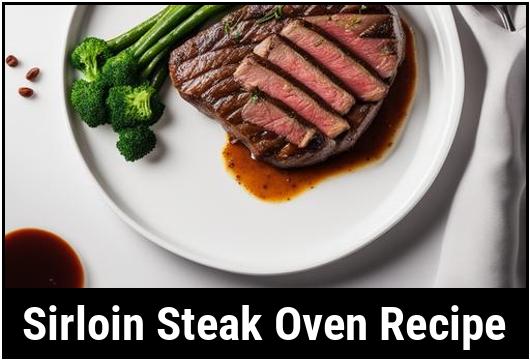
Sirloin Steak Oven Recipe: A Comprehensive Guide
Sirloin steak is a popular and flavorful cut of beef known for its tenderness and rich taste. While grilling is often the go-to method for cooking steak, using the oven can yield equally delicious results with a little know-how and technique. In this comprehensive guide, we’ll delve into the food science behind cooking sirloin steak in an oven, explore the process of selecting the best ingredients, detail the steps for preparing the steak, and provide an optimal cooking temperature and timing. Finally, we’ll present a mouthwatering sirloin steak oven recipe that’s sure to impress your taste buds.
Food Science Of Cooking Sirloin Steak In An Oven
Cooking sirloin steak in an oven involves a delicate balance of heat, time, and technique to achieve a perfectly cooked piece of meat. Understanding the food science behind this process can help you produce consistent and delicious results every time.
The primary goal when cooking steak is to develop a flavorful crust on the outside while retaining moisture and tenderness on the inside. This is achieved through a combination of caramelization, Maillard reaction, and proper heat distribution.
Caramelization occurs when the natural sugars in the meat react with heat, resulting in the browning of the surface. This creates a depth of flavor and texture that enhances the overall taste of the steak.
The Maillard reaction, named after French chemist Louis-Camille Maillard, is a complex chemical reaction between amino acids and reducing sugars that occurs when proteins are exposed to heat. This reaction produces a range of flavor compounds that contribute to the savory, umami taste associated with cooked meat.
When cooking sirloin steak in an oven, the key is to apply high heat initially to sear the exterior and lock in juices, then finish cooking at a lower temperature to ensure even doneness throughout the steak. This two-step process allows for optimal flavor development while preventing the meat from becoming tough or dry.
Choosing Ingredients
Selecting high-quality ingredients is essential for creating a delicious sirloin steak. When choosing your steak, look for cuts that are well-marbled with fat and have a vibrant red color. Marbling refers to the intramuscular fat within the meat, which adds flavor and tenderness.
For this recipe, we recommend choosing USDA Choice or USDA Prime grade sirloin steak for the best flavor and tenderness. These grades indicate a higher level of marbling and overall quality compared to lower grades.
In addition to the steak itself, you’ll also need a few basic ingredients to enhance the flavor of the dish. This may include kosher salt, freshly ground black pepper, and optionally, herbs and spices such as garlic powder, rosemary, or thyme for additional seasoning.
Preparing Ingredients
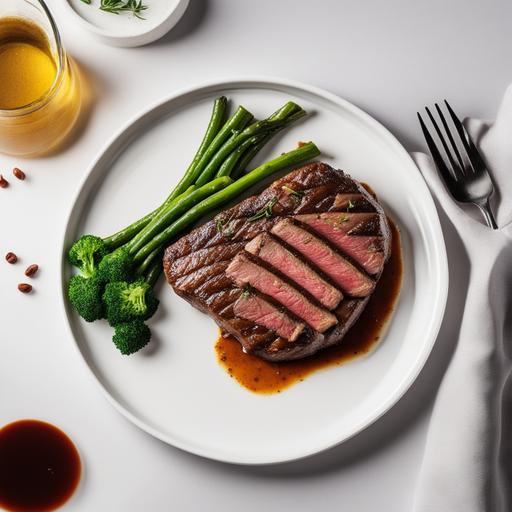
Properly preparing the ingredients is crucial for achieving a delicious and tender sirloin steak. Follow these steps to ensure your steak is ready for the oven:
-
Bring the steak to room temperature: Remove the steak from the refrigerator and let it sit at room temperature for 30-60 minutes before cooking. Allowing the steak to come to room temperature ensures more even cooking and helps prevent overcooking.
-
Season the steak: Generously season both sides of the steak with kosher salt and freshly ground black pepper. If desired, you can also add additional herbs and spices for extra flavor. Press the seasoning into the steak to ensure it adheres.
-
Preheat the oven: Preheat your oven to the desired temperature according to the recipe instructions. A high temperature of around 425°F (220°C) is recommended for the initial searing, followed by a lower temperature of around 350°F (175°C) for finishing.
-
Prepare a baking dish or cast-iron skillet: Choose a baking dish or cast-iron skillet large enough to comfortably fit the steak without overcrowding. Preheat the skillet in the oven for a few minutes to ensure it’s hot before adding the steak.
Optimal Oven Cooking Temperature & Timing
Achieving the perfect level of doneness for your sirloin steak requires careful attention to cooking temperature and timing. Here are some general guidelines to help you cook your steak to your desired level of doneness:
- Rare: 120-125°F (49-52°C) internal temperature, bright red center, very soft texture
- Medium rare: 130-135°F (54-57°C) internal temperature, warm red center, tender and juicy
- Medium: 140-145°F (60-63°C) internal temperature, pink center, slightly firmer texture
- Medium well: 150-155°F (66-68°C) internal temperature, slightly pink center, firmer texture
- Well done: 160°F (71°C) and above internal temperature, little to no pink, very firm texture
For a sirloin steak cooked to medium rare, we recommend the following cooking temperatures and timing:
- Searing: Preheat the oven to 425°F (220°C). Sear the steak for 2-3 minutes on each side until a golden crust forms.
- Finishing: Reduce the oven temperature to 350°F (175°C) and continue cooking for an additional 6-8 minutes, or until the desired level of doneness is reached.
Keep in mind that cooking times may vary depending on the thickness of the steak and the accuracy of your oven. It’s always best to use a meat thermometer to ensure precise cooking.
Sirloin Steak Oven Recipe
Now that you’re familiar with the food science, ingredient selection, and preparation process, it’s time to dive into the mouthwatering sirloin steak oven recipe:
Ingredients
- 2 (8-ounce) sirloin steaks, about 1 inch thick
- Kosher salt
- Freshly ground black pepper
- Optional: garlic powder, rosemary, thyme
Instructions
-
Preheat the oven: Preheat your oven to 425°F (220°C). Place a cast-iron skillet or baking dish in the oven to preheat as well.
-
Prepare the steaks: Pat the sirloin steaks dry with paper towels to remove any excess moisture. Season both sides of the steaks generously with kosher salt and freshly ground black pepper. For added flavor, sprinkle on garlic powder, rosemary, or thyme.
-
Sear the steaks: Carefully remove the preheated skillet or baking dish from the oven using oven mitts. Place the seasoned steaks in the hot skillet or dish and return it to the oven. Sear the steaks for 2-3 minutes on each side, or until a golden crust forms.
-
Finish cooking: Reduce the oven temperature to 350°F (175°C). Continue cooking the steaks for an additional 6-8 minutes, or until they reach your desired level of doneness. Use a meat thermometer inserted into the thickest part of the steak to check for doneness.
-
Rest and serve: Once the steaks are cooked to your liking, remove them from the oven and transfer them to a cutting board. Allow the steaks to rest for 5-10 minutes before slicing. This allows the juices to redistribute, resulting in a more tender and flavorful steak. Slice the steaks against the grain and serve immediately.
Cooking sirloin steak in the oven is a fantastic way to enjoy this flavorful cut of beef without the need for a grill. By understanding the food science behind the cooking process, selecting high-quality ingredients, and following proper preparation and cooking techniques, you can create a restaurant-quality steak right in your own kitchen. Whether you prefer your steak rare, medium rare, or well done, this oven recipe is sure to satisfy your cravings and impress your dinner guests. So fire up your oven, grab your favorite cut of sirloin steak, and get ready to indulge in a culinary masterpiece!
Doneness Checks
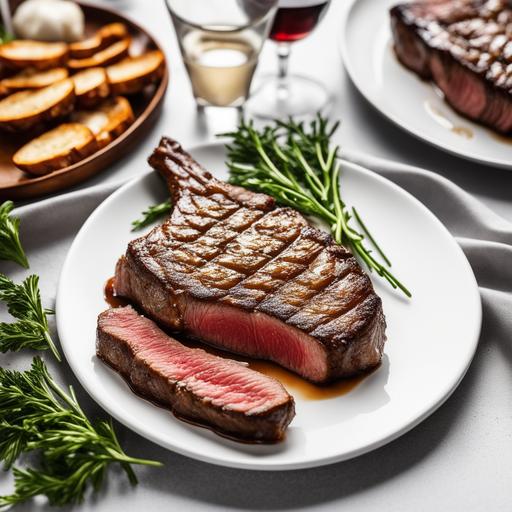
Cooking sirloin steak in the oven offers several advantages. It’s convenient, as you can prepare other components of your meal while the steak cooks. Additionally, oven cooking allows for consistent heat distribution, resulting in evenly cooked steak with a delicious crust.
Before diving into the cooking process, it’s essential to choose a high-quality sirloin steak. Look for steaks with marbling throughout the meat, as this indicates better flavor and tenderness. Additionally, consider the thickness of the steak, as thicker cuts may require longer cooking times.
Determining the doneness of your sirloin steak is crucial to achieving your desired level of juiciness and flavor. Here are some methods for checking the doneness of your steak:
Visual Inspection
- Rare: A rare steak will have a deep red center with a cool, soft texture.
- Medium-Rare: Medium-rare steak features a warm, red center with a slightly firmer texture.
- Medium: A medium steak has a pink center with a moderate firmness.
- Medium-Well: Medium-well steak has a slightly pink center with a firm texture.
- Well-Done: Well-done steak is brown throughout and has a firm, dry texture.
Touch Test
- Rare: Gently press the center of the steak with your finger; it should feel soft and squishy.
- Medium-Rare: Press the center of the steak with your finger; it should offer slight resistance but still feel tender.
- Medium: A medium steak will feel firm but still yield slightly to pressure.
- Medium-Well: Press the center of the steak with your finger; it should feel firm with minimal give.
- Well-Done: A well-done steak will feel very firm to the touch.
Meat Thermometer
Using a meat thermometer is the most accurate way to determine the doneness of your steak. Insert the thermometer into the thickest part of the steak:
- Rare: 120-125°F (49-52°C)
- Medium-Rare: 130-135°F (54-57°C)
- Medium: 140-145°F (60-63°C)
- Medium-Well: 150-155°F (66-68°C)
- Well-Done: 160°F (71°C) and above
Undercooking
Undercooking a sirloin steak can result in a tough, chewy texture and potentially unsafe consumption if not cooked to the recommended minimum internal temperature. Here are some common reasons why your steak may be undercooked:
- Insufficient Cooking Time: If you don’t cook the steak for long enough, especially if it’s a thicker cut, the center may remain rare or even raw.
- Low Oven Temperature: Make sure your oven is preheated to the correct temperature before cooking the steak. A low oven temperature can prolong cooking time and result in undercooked meat.
- Not Resting the Steak: Allow the steak to rest for a few minutes after removing it from the oven. This allows the juices to redistribute throughout the meat, ensuring even cooking and optimal flavor.
To prevent undercooking, always use a meat thermometer to check the internal temperature of the steak before serving. Remember that the steak will continue to cook slightly as it rests, so you can remove it from the oven when it’s a few degrees below your desired doneness.
Overcooking
Overcooking a sirloin steak can lead to a dry, tough texture and a loss of flavor. Here are some common reasons why your steak may be overcooked:
- High Oven Temperature: Cooking the steak at too high a temperature can cause it to cook too quickly on the outside while the inside remains undercooked.
- Leaving the Steak in the Oven for Too Long: It’s essential to monitor the steak closely as it cooks to avoid overcooking. Set a timer to remind yourself to check the steak’s doneness periodically.
- Using a Thin Cut of Steak: Thinner cuts of sirloin steak can cook much faster than thicker cuts. If you’re using a thin cut, reduce the cooking time accordingly to prevent overcooking.
To salvage an overcooked steak, consider slicing it thinly against the grain to minimize the toughness. Additionally, serve the steak with a flavorful sauce or gravy to add moisture and enhance the overall eating experience.
Troubleshooting
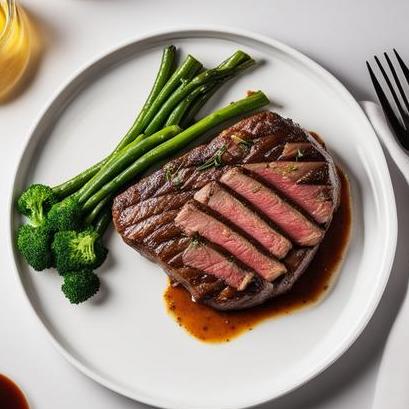
Encountering issues while cooking your sirloin steak in the oven is not uncommon. Here are some troubleshooting tips to help you overcome common challenges:
- Uneven Cooking: If the steak is cooking unevenly, rotate the pan halfway through the cooking time to ensure even heat distribution.
- Dry Steak: If your steak turns out dry, consider marinating it before cooking or serving it with a sauce or gravy to add moisture.
- Burnt Crust: If the crust of the steak becomes too dark or burnt, cover it loosely with foil during the remaining cooking time to prevent further browning while allowing the steak to continue cooking.
By addressing these issues as they arise, you can salvage your steak and still enjoy a delicious meal.
Recipe Variations
While the basic method of cooking sirloin steak in the oven remains the same, there are numerous variations and flavor profiles you can explore to customize your dish:
Garlic Butter Sirloin Steak
- Rub the steak with minced garlic, salt, and pepper before cooking.
- Top the steak with a pat of garlic herb butter just before serving.
Balsamic Glazed Sirloin Steak
- Marinate the steak in a mixture of balsamic vinegar, olive oil, and herbs before cooking.
- Brush the steak with a balsamic glaze during the last few minutes of cooking.
Cajun Spiced Sirloin Steak
- Coat the steak in a Cajun spice rub before cooking for a flavorful kick.
- Serve the steak with a side of spicy Cajun remoulade sauce.
Experiment with different seasonings, marinades, and sauces to find your favorite flavor combination.
Cooking sirloin steak in the oven is a convenient and foolproof method for achieving tender, flavorful results. By following the steps outlined in this guide, you can cook sirloin steak to your desired level of doneness with ease. Remember to check the steak’s internal temperature using a meat thermometer and to monitor its progress closely to avoid overcooking. With a little practice and experimentation, you’ll soon master the art of oven-cooked sirloin steak and impress your family and friends with your culinary skills.
Flavour Enhancement Tips
Sirloin steak is a popular cut known for its rich flavor and tenderness. Cooking sirloin steak in the oven is a convenient and delicious way to prepare this meat to perfection. Whether you’re a beginner or a seasoned chef, mastering the art of cooking sirloin steak in the oven can elevate your culinary skills and impress your guests.
-
Marinating: Marinating the sirloin steak before cooking can infuse it with additional flavor and tenderness. Choose a marinade that complements the natural richness of the steak, such as a mixture of olive oil, garlic, herbs, and citrus juice. Allow the steak to marinate in the refrigerator for at least 30 minutes to several hours before cooking.
-
Dry Rub: If you prefer a simpler approach, consider using a dry rub to season the sirloin steak. A mixture of salt, pepper, paprika, garlic powder, and herbs can create a flavorful crust on the steak as it cooks in the oven.
-
Seasoning: Before cooking, generously season the sirloin steak with salt and pepper to enhance its natural flavor. Allow the seasoning to penetrate the meat by letting it sit at room temperature for 20-30 minutes before cooking.
-
Butter Basting: During cooking, basting the sirloin steak with melted butter and aromatics like garlic and thyme can add richness and depth to its flavor. Simply spoon the melted butter over the steak periodically as it cooks in the oven.
Texture Enhancement Tips
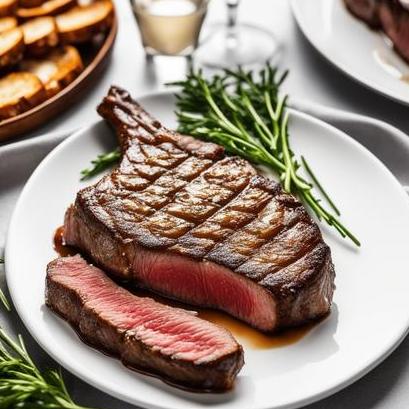
-
Room Temperature: Allow the sirloin steak to come to room temperature before cooking. This ensures that the steak cooks evenly throughout, resulting in a tender and juicy texture.
-
Searing: Before transferring the sirloin steak to the oven, sear it in a hot skillet or grill to create a flavorful crust on the outside. Searing locks in the juices and enhances the texture of the steak.
-
Resting: After cooking, allow the sirloin steak to rest for 5-10 minutes before slicing and serving. This allows the juices to redistribute within the meat, resulting in a more tender and flavorful steak.
-
Slicing Against the Grain: When slicing the sirloin steak, be sure to cut against the grain to ensure maximum tenderness. Slicing against the grain breaks up the muscle fibers, resulting in a more tender bite.
Cooking At Different Temperatures
-
Medium-Rare: For a medium-rare sirloin steak, preheat your oven to 400°F (200°C). Place the seasoned steak on a baking sheet or in a roasting pan and cook for 10-12 minutes, or until the internal temperature reaches 130-135°F (54-57°C).
-
Medium: To achieve a medium doneness, preheat your oven to 425°F (220°C). Cook the sirloin steak for 12-15 minutes, or until the internal temperature reaches 140-145°F (60-63°C).
-
Medium-Well: For a medium-well sirloin steak, preheat your oven to 450°F (230°C). Cook the steak for 15-18 minutes, or until the internal temperature reaches 150-155°F (66-68°C).
-
Well-Done: If you prefer your steak well-done, preheat your oven to 475°F (245°C). Cook the sirloin steak for 18-20 minutes, or until the internal temperature reaches 160°F (71°C) or higher.
Cooking Tips
-
Use a Meat Thermometer: To ensure that your sirloin steak reaches the desired level of doneness, use a meat thermometer to monitor its internal temperature. Insert the thermometer into the thickest part of the steak for an accurate reading.
-
Positioning in the Oven: Place the sirloin steak on a rack in the center of the oven for even cooking. Avoid placing the steak too close to the heating element, as this can cause it to cook unevenly or burn.
-
Basting: If desired, baste the sirloin steak with melted butter or pan juices during cooking to keep it moist and flavorful.
-
Resting Period: Allow the sirloin steak to rest for a few minutes after cooking to allow the juices to redistribute. This helps ensure that the steak remains juicy and tender when sliced and served.
Serving Suggestions
-
Side Dishes: Serve the sirloin steak with your favorite side dishes, such as roasted vegetables, mashed potatoes, or a crisp salad.
-
Sauces: Enhance the flavor of the steak with a homemade sauce or condiment, such as chimichurri, peppercorn sauce, or garlic butter.
-
Garnishes: Add visual appeal to your dish with fresh herbs, such as parsley or chives, or garnish with a sprinkle of flaky sea salt for added flavor.
-
Wine Pairing: Pair the sirloin steak with a complementary wine, such as a bold red like Cabernet Sauvignon or Malbec, to enhance the dining experience.
Conclusion
Cooking sirloin steak in the oven allows you to achieve tender, flavorful results with minimal effort. By following the tips and techniques outlined in this guide, you can elevate your steak-cooking skills and impress your family and friends with delicious, restaurant-quality meals. Whether you prefer your steak rare, medium, or well-done, mastering the art of cooking sirloin steak in the oven will surely make you a culinary star in your kitchen.
FAQS
What Ingredients Are Needed For A Sirloin Steak Oven Recipe?
To make a delicious sirloin steak in the oven, you will need the following ingredients: 1 ½ pounds of sirloin steak, 2 tablespoons of olive oil, 1 tablespoon of minced garlic, 1 teaspoon of salt, ½ teaspoon of black pepper, and any additional seasonings or herbs of your choice.
How Long Should I Marinate The Sirloin Steak Before Cooking It In The Oven?
It is recommended to marinate the sirloin steak for at least 30 minutes to enhance its flavor. However, if time permits, marinating the steak for up to 24 hours in the refrigerator will result in more tender and flavorful meat.
What Is The Ideal Oven Temperature For Cooking Sirloin Steak?
For a perfectly cooked sirloin steak, preheat your oven to 400°F (200°C). This temperature allows the steak to cook evenly and develop a desirable internal temperature while achieving a delicious crust on the outside.
How Long Should I Cook A Sirloin Steak In The Oven?
The cooking time for a sirloin steak in the oven will depend on your desired level of doneness and the thickness of the steak. As a general guideline, for a 1-inch thick sirloin steak cooked at 400°F (200°C), you should cook it for approximately 12-15 minutes for medium-rare, 14-17 minutes for medium, and 17-20 minutes for well done. However, it is important to use a meat thermometer to achieve the desired internal temperature.
Should I Let The Sirloin Steak Rest After Cooking It In The Oven?
Absolutely! Once the sirloin steak is cooked to your preferred level of doneness, remove it from the oven and let it rest for about 5-10 minutes. This resting period allows the juices to redistribute within the steak, resulting in a tender and juicier final product.


